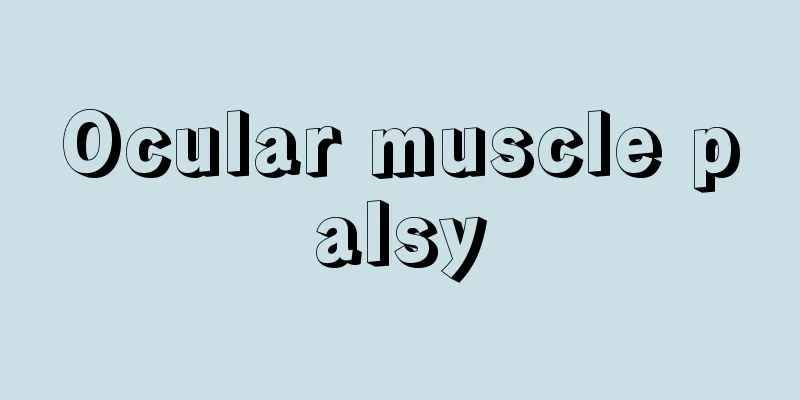Ocular muscle palsy

What is the disease? When we follow an object with our eyes, the muscles around the eyes are activated. When these muscles stop moving for some reason, it is called extraocular movement disorder or external ophthalmoplegia, or more commonly simply called ophthalmoplegia. The severity of ophthalmoplegia ranges from mild to severe. What is the cause?Broadly speaking, there are cases where the condition is caused by damage to the extraocular muscles themselves, and cases where the condition is caused by damage to the nerves that control the extraocular muscles. The lateral rectus muscle is the abducens nerve, and the superior oblique muscle is Therefore, if any part of these nerves is damaged, the muscles will eventually stop working and ophthalmoplegia will occur. For example, if there is an abnormality in the connection between the nerves and muscles (neuromuscular junction abnormality), stimuli are not transmitted to the muscles, resulting in ophthalmoplegia. A typical example is myasthenia gravis, which will be discussed in the next section. This is an autoimmune disease that develops when autoantibodies attack the neuromuscular junction. Other causes of nerve damage include inflammatory diseases such as multiple sclerosis, brain tumors, and orbital tumors that put pressure on the nerves. Diseases that affect the extraocular muscles themselves include genetic muscular dystrophy and mitochondrial myopathy, which cause muscles to stop working, and autoantibodies that attack the extraocular muscles. How symptoms manifestWhen we look at an object, we have the ability to see it with two eyes. This is called binocular vision. The positions of the two eyes are well adjusted depending on the position of the object. However, if the alignment is not done properly due to some illness, you will see two objects. In cases of mild ophthalmoplegia, double vision occurs when the eyes are moved widely, but in severe cases, patients may see two objects even when facing straight ahead. Ophthalmoplegia can sometimes be accompanied by pain behind the eye. Testing and diagnosisTo examine the nature of diplopia, ophthalmologists will visually examine the eyelids and eye position, and then observe changes in eye movement. With both eyes open, they will observe binocular conjugation (movement of both eyes at the same time), and then observe monocular movement. This will determine roughly which extraocular muscle is insufficient or paralyzed. In addition, a Hess chart test will be performed to quantitatively record eye movement disorders. Next, we observe the muscles and nerves in order to determine where the abnormality is occurring, and assume the location from peripheral to central, and then use neuroimaging tests such as CT or MRI to diagnose both the location and the cause. Treatment methodsIf the ophthalmoplegia is clearly inflammatory, systemic corticosteroids are effective, whereas if it is noninflammatory and caused by a tumor, surgery is required. If the cause is other than ischemia, the condition will be monitored. If the condition remains stable after 4 to 6 months of monitoring, surgery to correct the frontal position will be performed. If diplopia becomes a concern during follow-up, prism-based eyeglass correction will be used. However, in cases of ophthalmoplegia with disconjugate eye movements, the prisms may not be aligned properly, and one eye may be displaced. What to do if you notice an illnessIf you experience double vision, we recommend you visit an ophthalmologist. If it is monocular diplopia, it is purely an ophthalmological disorder, but if it is binocular diplopia, the cause must be diagnosed. It is a good idea to first narrow down the cause and then get a referral to a specialist for that specific cause. Kenji Matsushita Source: Houken “Sixth Edition Family Medicine Encyclopedia” Information about the Sixth Edition Family Medicine Encyclopedia |
どんな病気か 私たちが物を眼で追いかける時には、眼のまわりについている筋肉がはたらきます。これを これらの筋肉が何らかの理由で動かなくなった状態を、外眼筋運動障害あるいは外眼筋麻痺といい、一般には単に眼筋麻痺と呼んでいます。眼筋麻痺の程度は、軽いものから重いものまでいろいろです。 原因は何か大別して、外眼筋自体に障害が起こる場合と、外眼筋を支配している神経の障害によって起こる場合があります。 外直筋は外転神経、上斜筋は したがって、これらの神経のどこの部分が障害を受けても、最終的に筋肉がはたらかなくなって眼筋麻痺が起こります。 たとえば、神経と筋肉のつながりの部分に異常が起こると(神経筋接合部異常)、筋肉への刺激が伝わらなくなって眼筋麻痺になります。代表的な病気として、次項で述べる筋無力症(きんむりょくしょう)があります。これは自己免疫疾患のひとつで、自己抗体が神経筋接合部を攻撃することによって発症します。 そのほか、神経障害の原因として、多発性硬化症のような炎症性疾患が関与する場合、脳腫瘍(しゅよう)や眼窩(がんか)腫瘍が神経に圧迫および 外眼筋それ自体に障害を起こす病気としては、遺伝的に筋肉がはたらかなくなる筋ジストロフィーやミトコンドリアミオパチー、自己抗体が外眼筋を攻撃して起こる 症状の現れ方私たちの眼は物を見る時、2つの眼で見る力があります。これを両眼視といいます。2つの眼の位置は、物がある位置によってうまく調節されています。 しかし、何らかの病気で位置合わせがうまくいかないと、物が2つに見えてしまうことになります。これを 複視の出方は、眼筋麻痺が軽い場合は大きく眼球を運動させた時に生じますが、重症になると正面を向いていても2つに見えるようになることがあります。 眼筋麻痺は、時には眼の奥の痛みを伴うこともあります。 検査と診断複視の性状を調べるため、眼科では視診による眼瞼や眼球位置の観察のあと、眼球運動の変化を観察します。両眼を開いた状態で両眼の共同性運動(2つの眼球を同時に動かす運動)をみたあと、単眼での運動を観察します。ここまででおおよそ、どの外眼筋の不全または麻痺があるかわかります。さらに、眼球運動障害を定量的に記録するために、ヘスチャートという検査も行います。 次に、異常がどこで生じているのかを筋肉、神経の順に観察し、末梢から中枢までの部位を想定し、CTやMRIなどの神経画像検査によって、部位診断から原因診断までを行います。 治療の方法眼筋麻痺が炎症性のものとはっきりわかる場合は、ステロイド薬の全身投与が効果的です。非炎症性で腫瘍が原因であれば、外科的処置が必要になります。 虚血性など、それ以外の原因であれば経過観察になります。4~6カ月の経過観察のあと、なお症状が固定していれば手術による正面眼位の 経過観察中に複視が気になったら、プリズムを使った眼鏡矯正をします。しかし、非共同性眼球運動を示す眼筋麻痺ではプリズムが合わない時もあり、片眼 病気に気づいたらどうする物が2つに見えたら、眼科を受診することをすすめます。単眼での複視なら純粋に眼科の病気ですし、両眼複視なら、その原因診断を行う必要があります。 まず原因を絞り込んでから、原因別に専門医の紹介を受けるとよいでしょう。 松下 賢治 出典 法研「六訂版 家庭医学大全科」六訂版 家庭医学大全科について 情報 |
<<: Ophthalmoplegic headache - ophthalmoplegic headache
Recommend
Gansenji Temple
This is a Jodo Shinshu Honganji temple in Naniwa-k...
Natural park - Shizenkoen
Parks were established under the Natural Parks Law...
Ankamon-in Shijo - Ankamon-in Shijo
⇒ Abutsuni Source: Kodansha Digital Japanese Name ...
saucer bug
…An insect of the Hemiptera family, family Corobo...
Kui-feng-jing (English: Kui-feng-jing)
This refers to a bronze mirror with a dragon-shape...
Neo-vitalism
…However, there were many vitalists, such as C. B...
Agharta
... This legend was introduced to Europe in the 1...
Boulevard Solitude
…He first used twelve-tone technique in his Violi...
Haga Zenka
?-1372 A military commander during the Nanboku-ch...
Fish dishes - Fish dishes
Dishes that mainly feature fish, shrimp, squid, o...
Care - Yojo
[Noun] (Suru) 1. Pay attention to your lifestyle a...
Hammering (forging) - Uchimono
…It is also called uchimono (forged metal) or tsu...
Thalassemia
Hemolytic anemia caused by a genetic defect and ba...
Soya Main Line
The name of the Hokkaido Railway Company's tr...
The 47 Ronin of Ako
In 1702 (Genroku 15), 47 ronin including Oishi Yos...









